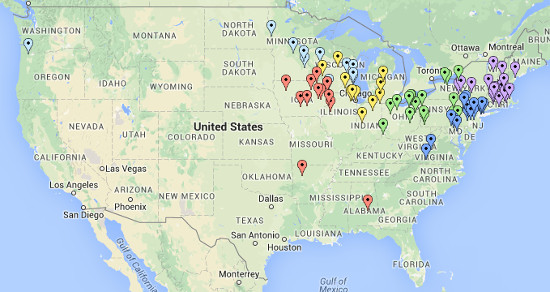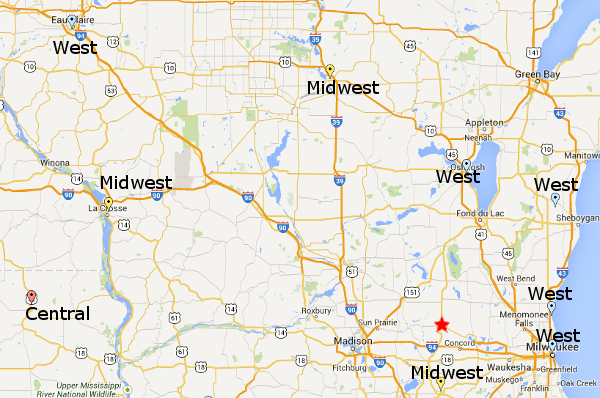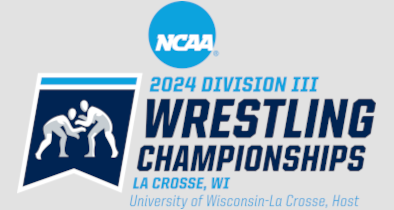
Division III Regional Alignment for 2014-2015
The 2011-2012 season was the first to feature the current regional qualification system. The Division III teams were each placed into one of six regional tournaments with the top three finishers at each weight qualifying for the NCAA Championships. Prior to 2012, each conference/regional championship was allotted a different number of qualifiers based on a formula that accounted for performance of that conference in previous NCAA Championships. This was also the era of wildcard meetings where coaches voted on the most deserving qualifiers when the number allotted to a conference was not a multiple of ten. The past few years have seen the total number of qualifiers increase from 160 to 170 under the wildcard system and now to the current 180 under the regional system.
| Region | Teams |
|---|---|
| West | 11 |
| Midwest | 12 |
| Central | 13 |
| Mideast | 18 |
| East | 18 |
| Northeast | 18 |
| Total | 90 |
The move to the regional system was prompted primarily by the desire of the NCAA to remove historical data (i.e., results from prior seasons) from the process that determines who qualifies for the NCAA Championships in all sports. When Division I wrestling moved to its current system involving coaches rankings, RPI, and Gold and Silver Standards (explained here), that left Division III wrestling as the only championship (out of nearly 90 championships at the time) in the entirety of the NCAA still relying on historical data.
In order to completely remove historical data from the qualifying process, the regions would ideally be determined solely on a geographical basis with an even number of teams in each region. That said, it is possible to argue that some regions should have fewer teams in order to minimize travel distances. Regardless, the system put in place grouped the teams into six regions. For 2015, the three regions in the eastern half of the wrestling map are approximately 50% larger than that three regions in the western half. (These numbers reflect the fact that Yeshiva has not yet attended a regional and that Maranatha has shuttered their program, at least for this year)
 There are also a few places on the map where things look a little strange. Some of this was done in order to keep some of the all-sport conferences (OAC, Centennial, IIAC) together, but it is worth pointing out.
There are also a few places on the map where things look a little strange. Some of this was done in order to keep some of the all-sport conferences (OAC, Centennial, IIAC) together, but it is worth pointing out.
First, there’s the East/Mideast divide pictured here. It is a little bit strange, but it makes some sense when considering that the idea was to keep some conferences together, so Centennial members McDaniel and Gettysburg stay with their conference teams that are further to the East.
It is an open question as of now whether the desire to keep conference teams grouped together will remain important as teams are added and the regions are realigned. The NCAA has indicated that the current maximum region size is 18 teams which is why the addition of Daniel Webster College to the Northeast Region this year necessitated moving Oswego into the Mideast Region. Now there are three regions at this maximum of 18. In order to hold regions at or below 18 teams without major realignment, multiple teams will have to change regions next year in order to fit Greensboro and Hampden-Sydney into regions that make geographical sense. Adrian and Millikin can likely slot in somewhere without causing major movement.
Things are also a bit mixed up in the western part of the Division III map.
There are four teams (five if Maranatha, represented by the red star, was competing this year) that are pretty far to the east and are farther to the east than at least three teams that are not in the West region.
It is expected that that regions will be evaluated and realigned after the 2015-2016 season. Here is one proposal for how to do so. These are some of the guidelines used to generate what is to follow.
1. Conferences do not have to stay together
2. Keep the same, or close to the same, number of teams in each region
3. Simple boundaries between regions are better than complicated ones
4. Current or past team quality is not considered. This is the only way to truly eliminate the use of historical data.
5. This includes all teams that have either announced new teams for next year or are in the provisional period of joining the NCAA. Some of these teams will not yet be eligible for the postseason for 2016-2017.
This results in a list of 97 teams (Yeshiva and Maranatha were excluded from this alignment but could easily be added should they return to postseason competition). With 97 teams, there are five regions with 16 teams and one with 17 teams. No team should have to cross a regional border to travel to any other team in their region. Click below to see a proposed regional map including these 97 teams.
Division III Regional Realignment Proposal Map | List of Teams by Proposed Region
Some caveats to consider:
1. It is likely that more schools will start teams between now and the 2016-2017 season. This season, there were three new teams. Next season, there will be at least four. This map only accounts for what we know now.
2. This is not necessarily the absolute best arrangement of teams. It is possible to meet the guidelines above but come up with a different, or even better, proposal.
3. At some point, keeping six regions will not make sense as there will be too many teams. If a seventh or eighth regional is added, the whole system will have to change if the tournament stays at 180 qualifiers.
With any luck, Division III wrestling will continue to grow, and this proposal, along with any others, will have to adjust to account for the growing demand for wrestling at Division III colleges.







Wartburg and Augsburg in the same region with each region having the same number of qualifiers? Is that going to be equitable?
Re: Craig. Historically, I’d say no, but currently, yes, even if it hurts my beloved Auggies. If you believe, as I do that the Auggies are going to return to their former top-four every year status, then being the same region as Wartburg make it a tough region, no matter what.
In years where Augsburg and Wartburg had 16 to 18 or more qualifiers between them, you could have had two top-ranked 10 wrestlers in the finals of the region at every weight and generally that top 2 would have been an Auggie and a Knight. More recently, Augsburg has still done very well in the new West Region, even with a great Concordia team there. The rest of the region is comparatively weak though. St. John’s and St. Olaf have fallen way off from around 2008-2011 or so. Teams like UW-Eau Claire and Maranatha can’t always field full squads.
The proposed realignment is much better overall from a nationwide perspective, but then the Midwest becomes the new West in terms of difficulty, dropping Wartburg and Coe (and to a lesser extent Cornell and the other IIAC schools) and picking up schools like Platteville, Oshkosh and Lakeland are not equal. I’m not sure if Wabash moved in to this region or they were already there, but if it did, that’s a strong team added too.
In the current proposal, I’d like to see the West pick up La Crosse and Stevens Point and drop Loras and Augustana. Geographically it’s a better fit.
The way the East, North East and South East are configured seems better than it was previously, but there seems to be enough leeway to go either way on schools like Bridgewater State, Lycoming, TCNJ, DelVal, Muhlenberg, etc.
—-
DIII wrestling aside, aligning things geographically is always going to have its problems. For instance in this year’s DII volleyball regional at Minnesota Duluth, the nationally-ranked no. 2, no. 3, no. 4, no. 5 and no. 6 teams competed.
That’s the current equivalent of Whitewater, Concordia, Wabash, La Crosse and Augsburg all in one regional. That’s just going to happen sometimes.
You just used historical data to make an argument, which is what the NCAA is purposely trying to avoid.
Well, if the NCAA is not going to allow historical data to be used, then perhaps they should use some component of the current year data (like they do for D1) to determine the number of qualifiers per region. No need for wildcards, just allocate the number of qualifiers by weight per region based on some formula in advance of the region tourneys just like they do for D1 (but without awarding wildcards after the region tourneys). I’m not one to root for Augsburg or Wartburg but if equity and common sense are concerns, a region with both of those teams should receive more qualifiers than other regions or they should be put in different regions. If equity and common sense aren’t concerns, then by all means, allocate the same number of qualifiers to the weakest and strongest regions. If you do that, you won’t necessarily figure out who the best D3 wrestlers but you will get equal representation from each region. Depends on what the goal is but for my money, I would like too see who the best D3 wrestlers are.
Giving equal number of qualifiers to each region (with the Burgs being in the same region) would be like allocating the same number of qualifiers to the Big 10 and EIWA as the MAC. Makes the process easier but would that really be equitable and a good way to figure out who the best D1 wrestlers are? Of course, D3 schools are more limited in budget and can’t travel as much to wrestle all of the D3 schools making a current year ranking system more challenging, but you seem to be able to do a D3 national ranking pretty well so I’m sure there is way to arrive at an equitable formula for determining qualifiers per weight for each region.
A DI style system is another valid solution. It is better than having an 11 team region and an 18 team region with the same number of qualifiers.
You’re illustrating the problem with using historical data. Why should Wartburg and Augsburg be treated differently than other schools? This year, La Crosse, Wabash, and Whitewater are all in the same region and all are ranked higher than Augsburg. Situations like that are bound to happen every year, and the balance of power will constantly shift.
The same reason that the Big 10 conference should receive more qualifiers than every other conference: because they have a greater number of better wrestlers at each weight than any other conference and because Augsburg and Wartburg have won every single championship since 1995. So that’s not just a one year anomaly. I’m okay with not using historical data but current year data should be used to determine the numbers of qualifiers per weight per region. Selfishly, since I root for the University of Chicago, it would be great if Augsburg and Wartburg are in the same region (which does not include the U of C) and in a region that receives the same number of qualifiers as every other region. However, if you are truly trying to figure out who the best D3 wrestlers are and doing what’s equitable, regions should not all receive the same number of qualifiers (particularly if one is really strong and one is really week).
P.S. Thank you for your great coverage of D3 wrestling.
This topic always brings some good discussion from both sides. I personally agree that some aspect of current year performance needs to be incorporated if the formula. For basic conversation I took the proposed regional alignment from this article and overlaid the estimated team points from the Jan 14, 2015 d3wrestle team rankings to get a gauge for the possible tournament balance between regions this year. It’s far from perfect but helps give a starting point.
West 208
Midwest 128
Central 143
East 90
Northeast 103
Southeast 95
Wartburg and Augsburg have won the national title for this long because the NCAA is too lazy to monitor their corrupt recruiting practices! Any team that can award an athelete an academic scholarship when the kid only has an 84 is bound to stockpile talent and win big! I mean come on!! Wartburg recruited six state champs this year…Gimmie a break! These kids are getting the ole Wartburg special..everybody that’s been around long enough knows that! Augsburg does it, Ithaca does it! Any private school with enough administrative support does it! If I remember correctly, Swenson argued historical data for the current regional alignmet when it was created. This was a means to ensure thr burgs could continue to take the majority of their teams to nationals every year! Also didn’t the Northeast have the highest percentage of AA’s last year? there is a lot of political crap within the confines of DIII to say the least! This proposal is most definitely a step in the right direction! Hopefully our coaches wil man up and support this and advocate for this at Nationals! Enough of the lop-sided BS! Make it equitable for every Region!!! See ya at Nashies!
Re: Adam.
That’s an interesting way to look at it. With the proposed West and Augsburg, Wartburg and Concordia in the same region, you’d get the following top three (per d3wrestle rankings):
125:
1. Fuenffinger (Augsburg)
6. Elizalde (Loras)
10. Agnitsch (Wartburg)
133:
5. Campo (Wartburg)
8. Anderson (Central)
9. Bartschenfeld (Augsburg)
141:
2. Van Anrooy (Luther)
6. Bergeron (Concordia)
7. Henle (St. John’s)
149:
4. Martin (Wartburg)
5. Travis (Dubuque)
9. Keeter (Augsburg)
157:
10. Wagenhoffer (Wartburg)
ct. Elmer (St. Olaf)
ct. Van Anrooy (Luther)
165:
2. Sewera (Coe)
6. Steiert (Wartburg)
9. Krogstad (Concordia)
174:
5. Harrington (Coe)
9. Gardner (Concordia)
10. Welter (Wartburg)
184:
4. DeVilbiss (Luther)
5. Lowy (Central)
7. Reyhons (Augustana)
197:
7. Michaelis (St. John’s)
8. Levsen (Wartburg)
9. Watson (Loras)
285:
5. Nagle (Wartburg)
7. Longendyke (Augsburg)
9. Gibson (St. Olaf)
Qualifiers:
Wartburg: 8
Augsburg 4
Concordia 3
Luther 3
Central 2
Coe 2
Loras 2
St. John’s 2
St. Olaf 2
Augustana 1
Dubuque 1
Actually at 125, Page is ranked above Agnitsch, Wartburg would have 7 and Central 3.
At 157, DeWitt is ahead of Waggenhoffer, so drop 1 from Luther and add 1 to Loras.
blast, what are you referring to when you’re referencing 84?
I think moving forward each region needs to come up with Regional rankings for the Top 8 wrestlers and all coaches have each team of the region vote. When the end of the year comes up – especially with the big regions – not all teams see each other and coaches have openly said they use D3 wrestling to help with voting. If we are going to use any type of rankings there needs to be more than a top 10 national ranking – but also if we are growing rankings for any type of further justification there should be more than one or two coaches involved in the rankings and say of who goes where. Overall great post and positive discussion point
CK, for 90 schools, top 10 sounds about right to me.
Regional rankings, I’d support based on all region coaches voting. Top 6 or 8 per region though.
Hopefully better regions fixes thos, but they’re aren’t always 8 wrestlers worth ranking in a given weight class.
I think only ranking 10 out of 90+ schools is a disservice to a lot of the wrestlers. I know D1 ranks top 30 or so for only 70+ schools. I like AV’s Top 26. I just think more coaches should help provide input into his. I think the Top 10 is not enough. For Regional Rankings they seed Top 8 – so I think it makes sense to rank top 8 but only have the regional coaches vote on it
d1 weights are reevaluated every year based on the strength of that weight in the said conference, and although it would take some work, it would be better for the wrestling if each weight class was evaluated by conference or region so some weights would have the winner going only and some weights may have top 8 going if the weight is deep enough
Why not have 8 regions of 12 each and allow top 4 from each to qualify?
I’d even favor skipping regionals and using top 8 per region as voted on by head coaches as national qualifiers. Ties equal rat tails.
^^^Dumbest post of the year award…thanks for showing up Sal. Take a lap.
Actually, we could save a lot of time and money if we just skipped the post season completely and had the coaches vote- Most votes is the national champ and top 8 vote getters at each weight are the All Americans.
My point is the season is too long and the east has 50% more teams per region but same number of qualifiers…obviously the coaches voting would be based on the wrestlers records during the year and placement at tournaments. Go ahead and make snarky comments, you can’t hurt my feelings.
Give Sal a break guys! At least he’s trying to contribute towards a solution!! Here’s an idea….advocate for the friggin proposal above!!! It makes more sense than anything I’ve seen or heard thus far!
East and West become the next power house regions with this alignment. Southeast takes on all the new programs and becomes a joke.
Comments are closed.